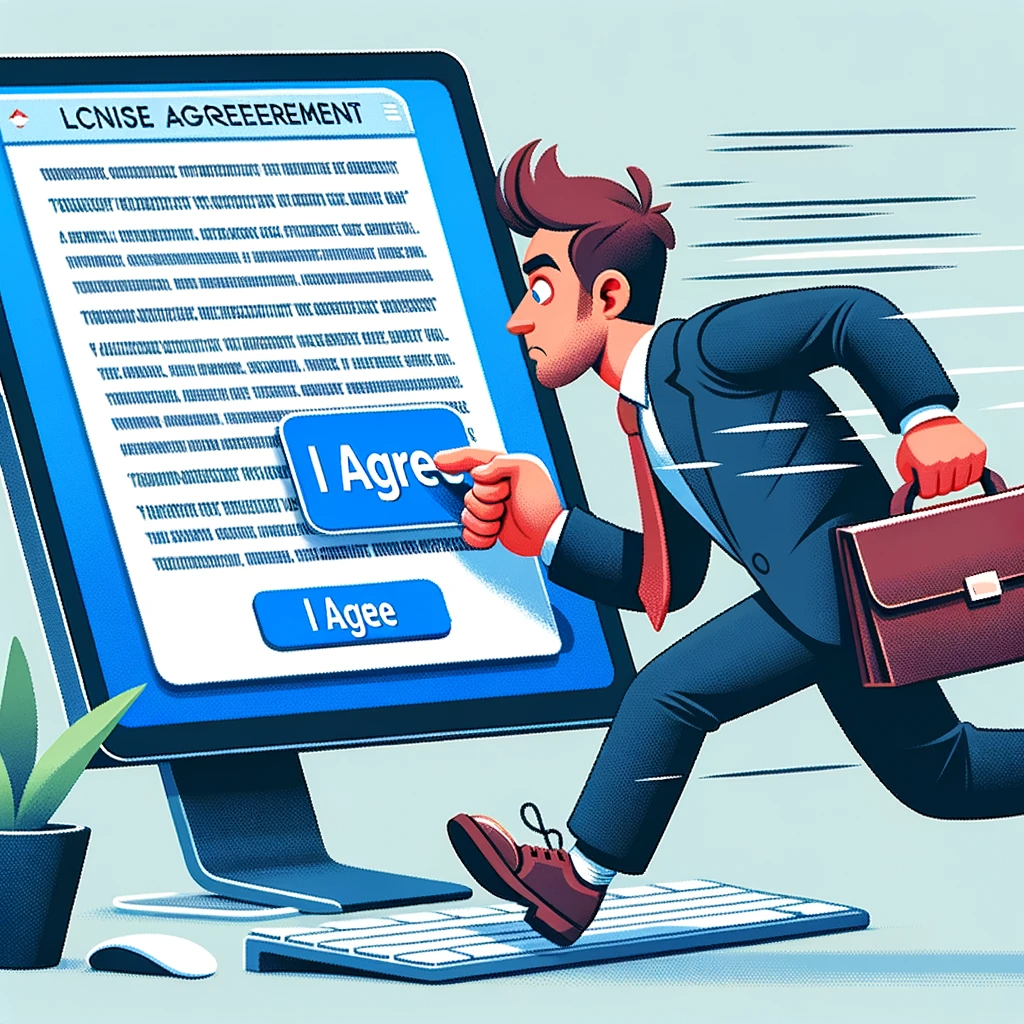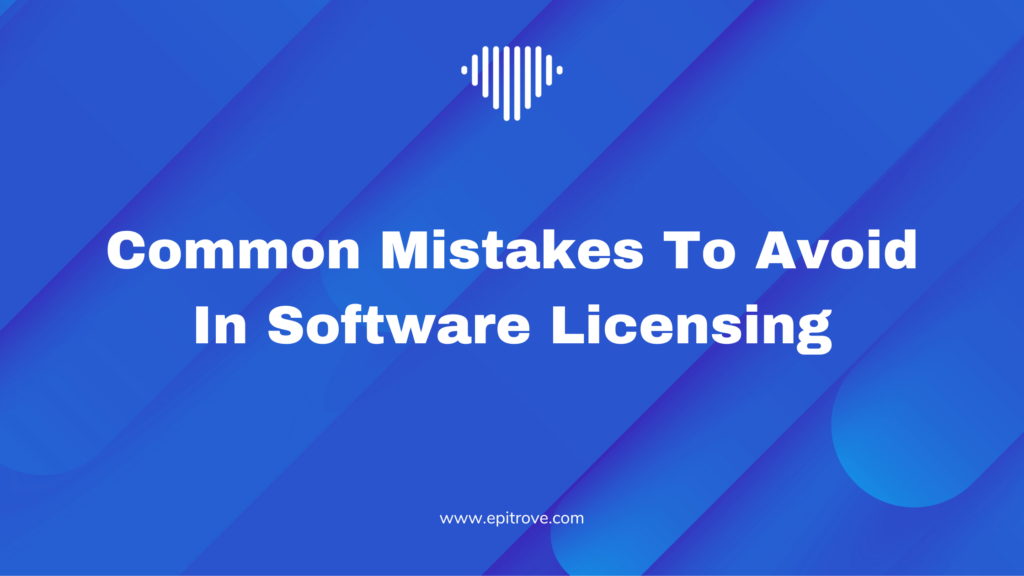Are you making these enterprise software licensing mistakes that could cost you time, money, and even reputation?
Getting your hands on the right enterprise software can feel like a big win, but the game isn’t over yet. There’s a tricky part that follows – navigating the world of software licensing.
Understanding and avoiding common licensing mistakes is vital for staying compliant and maximizing the benefits of your software investments.
In this blog, we will shed light on 10 common software licensing mistakes that you need to be aware of and avoid. From overlooking license terms and conditions to failing to track software usage, we’ll explore the pitfalls that can easily lead to legal disputes and financial penalties. You’ll also learn how to navigate complex licensing models, deal with software audits, and protect your organization’s intellectual property.
Don’t let licensing mistakes hinder your business growth and success. Join us as we uncover the most common pitfalls and provide you with actionable tips to ensure a smooth and risk-free software licensing journey.
The importance of software licensing

Software licensing is an essential aspect of modern business. It allows organizations to legally use software while ensuring that the software creators are compensated for their work. Unfortunately, many businesses overlook or underestimate the significance of proper enterprise software licensing, which can lead to severe consequences.
One of the primary reasons why software licensing is crucial is that it protects your organization from legal disputes and financial penalties. Without a proper license, you may be infringing on intellectual property rights, which can result in costly lawsuits. Additionally, using unlicensed software can damage your reputation and negatively impact your relationships with clients and partners.
Moreover, software licensing provides you with the opportunity to unlock the full potential of your software investments. By understanding and adhering to licensing terms and conditions, you can ensure that you are using the software in a way that maximizes productivity and efficiency. It also allows you to access updates, security patches, and customer support, which are often exclusive to licensed users.
In summary, enterprise software licensing is not just a legal requirement, but also a strategic advantage. It protects your organization, enhances your software utilization, and promotes a positive business image.
Now that we understand its importance, let’s dive into the 10 common software licensing mistakes you should avoid.
Common enterprise software licensing mistakes
Mistake 1: Failing to read the license agreement
One of the most common enterprise software licensing mistakes is the failure to thoroughly read and understand the license agreement. Many users tend to skip past the fine print and click “I agree” without fully comprehending the terms and conditions they are agreeing to. This can have serious consequences.
The license agreement outlines the rights and restrictions associated with the software. It may specify the number of users allowed, the duration of the license, and any limitations on usage. By not reading the agreement, you may unknowingly violate these terms and put your organization at risk. It is essential to take the time to carefully review the license agreement and seek legal advice if necessary.
Read more at: You ignore everything, and click “I agree”

Mistake 2: Using unlicensed software
Using unlicensed software is a serious offense that can have severe legal and financial consequences. Unlicensed software refers to using software without obtaining the necessary licenses from the software vendor. This can include using cracked or pirated versions of software or using more copies than permitted by the license.
While unlicensed software may seem like a cost-saving measure, it exposes your organization to significant risks. Not only are you violating copyright laws, but you are also missing out on essential updates, security patches, and technical support. In the event of a software audit, the penalties for using unlicensed software can be substantial, including hefty fines and legal liabilities.
To avoid this mistake, always ensure that you have valid licenses for all the software your organization uses. Keep track of the licenses, their expiration dates, and the number of users permitted. Regularly audit your software usage to ensure compliance and consider implementing a software asset management system to simplify the license management process.

Mistake 3: Ignoring license restrictions
License restrictions are often overlooked or disregarded, leading to compliance issues. License restrictions can include limitations on the number of users, the devices on which the software can be installed, or the geographic locations where it can be used. Ignoring these restrictions can result in non-compliance and potential legal consequences.
It is essential to understand and adhere to the license restrictions imposed by the software vendor. This may involve monitoring the number of users, ensuring that the software is only installed on authorized devices, and restricting usage to approved locations. By strictly following these restrictions, you can avoid legal disputes and maintain a compliant software environment.
Remember, license restrictions are put in place for various reasons, including revenue protection, security, and fair usage. Ignoring or bypassing these restrictions not only puts your organization at risk, but it also undermines the integrity of the enterprise software licensing model.
Mistake 4: Overlooking license expiration dates
License expiration dates are often overlooked, leading to situations where organizations continue using software without a valid license. This mistake can expose your organization to legal liabilities and disrupt your operations if the software is disabled after the license expires.
To avoid this mistake, implement a robust license management system that tracks the expiration dates of all your software licenses. Set up reminders to renew licenses before they expire, ensuring uninterrupted access to critical software. Additionally, consider negotiating multi-year licenses with vendors to reduce the administrative burden of frequent renewals.
Overlooking license expiration dates is a common oversight, but one that can have significant consequences. Stay proactive and stay on top of your license renewals to maintain a compliant and efficient software environment.
Mistake 5: Sharing licenses improperly
Sharing software licenses among multiple users without proper authorization is another common licensing mistake. While it may seem like a cost-effective solution, improper license sharing can lead to non-compliance and legal issues.
Each software license is typically issued for a specific number of users or devices. Sharing licenses beyond the permitted limit violates the terms of the license agreement and can result in penalties. Additionally, unauthorized users may not receive the necessary updates and support, compromising the security and stability of the software.
To avoid this mistake, ensure that each user has their own license or is covered by a valid license. Implement user management systems that enforce licensing restrictions and prevent unauthorized access. Regularly review and adjust your license usage to match the number of users and devices in your organization.

Mistake 6: Not keeping track of license usage
Failing to keep track of software license usage can lead to non-compliance and overspending. Without proper monitoring, you may inadvertently exceed the number of permitted users or devices, putting your organization at risk.
Implementing a software asset management system can help you keep track of license usage and ensure compliance. This system allows you to monitor the number of users, track installations, and generate reports for license audits. Regularly review your license usage and make adjustments as needed to avoid overutilization or underutilization of licenses.
By keeping track of license usage, you can optimize your software investments, eliminate unnecessary costs, and ensure that you are using the software within the bounds of your licenses.
Mistake 7: Failing to update software licenses
Software licenses often come with expiration dates and version upgrades. Failing to update your licenses can lead to non-compliance and missed opportunities for improved functionality and security.
Stay proactive and regularly review your software licenses. Identify licenses that are nearing expiration and renew them in a timely manner. Explore options for upgrading licenses to newer versions that offer enhanced features and improved performance. By keeping your licenses up to date, you can ensure that your organization benefits from the latest advancements in software technology.
Additionally, consider implementing a license management system that alerts you when updates or renewals are due. This can streamline the process and help you stay on top of your license maintenance.
Mistake 8: Using pirated software
Using pirated software is not only illegal but also poses significant risks to your organization. Pirated software refers to unauthorized copies of software that are distributed without the permission of the software vendor.
Pirated software often contains malware or other security vulnerabilities that can compromise your systems and data. Moreover, using pirated software exposes you to legal liabilities, including hefty fines and potential lawsuits. It also undermines the software industry as a whole by devaluing intellectual property rights.
To avoid this mistake, always obtain software from reputable sources and ensure that it is properly licensed. Educate your employees about the risks of using pirated software and enforce strict policies against its usage. Invest in robust cybersecurity measures to protect your systems from malware and other cyber threats.
Remember, using pirated software may seem like a shortcut, but it can have severe consequences. Protect your organization and respect the rights of software creators by using only legitimate, licensed software.
Read more at: Why You Shouldn’t Use Pirated Software (But Why People Still Do)

Mistake 9: Not understanding license compliance
Lack of understanding of license compliance can lead to unintentional violations and legal disputes. Each software license comes with specific terms and conditions that must be followed to ensure compliance.
Educate yourself and your team about license compliance. Familiarize yourself with the license agreement, including usage restrictions, permitted number of users, and any usage reporting requirements. Implement processes and procedures to ensure that your organization adheres to these terms and conditions.
Consider appointing a dedicated license compliance officer or engaging legal counsel to provide guidance on license compliance matters. Regularly review your license compliance practices and make adjustments as needed to maintain a compliant software environment.
Read more at: Software License Compliance
Mistake 10: Neglecting software audits
Neglecting software audits is a mistake that can have serious consequences. Software vendors often conduct audits to ensure that their customers are using the software in compliance with the license agreement. Failing to cooperate with a software audit can result in legal action and financial penalties.
To avoid this mistake, be proactive and prepare for software audits in advance. Keep accurate records of your software licenses, usage, and compliance efforts. Regularly review your license agreements to ensure that you are fully aware of your rights and responsibilities.
If you receive a software audit request, promptly respond and cooperate with the vendor. Provide the necessary information and documentation to demonstrate your compliance. If you discover any non-compliance during the audit, take immediate steps to rectify the situation and negotiate a resolution with the vendor.
By treating software audits seriously and maintaining proactive compliance practices, you can protect your organization from legal disputes and financial penalties.
How to avoid enterprise software licensing mistakes
Now that we have explored the 10 common software licensing mistakes, let’s discuss how to avoid them and ensure a smooth and risk-free software licensing journey. Here are some actionable tips:

1. Read and Understand License Agreements: Take the time to thoroughly review and comprehend the license agreements before agreeing to them. Seek legal advice if needed.
2. Obtain Valid Licenses: Ensure that you have valid licenses for all the software your organization uses. Keep track of license expiration dates and renew them in a timely manner.
3. Adhere to License Restrictions: Understand and follow the license restrictions imposed by the software vendor. Monitor the number of users, device installations, and geographic usage to maintain compliance.
4. Track License Usage: Implement a software asset management system to keep track of license usage. Regularly review and adjust your license usage to match the number of users and devices in your organization.
5. Update Software Licenses: Stay proactive and regularly review your software licenses. Renew licenses before they expire and explore options for upgrading to newer versions.
6. Educate Employees: Educate your employees about the importance of enterprise software licensing and the risks associated with using unlicensed or pirated software.
7. Implement Strict Policies: Enforce strict policies against the use of unlicensed or pirated software. Implement user management systems that prevent unauthorized access and license sharing.
8. Prepare for Software Audits: Keep accurate records of your software licenses, usage, and compliance efforts. Cooperate with software audits and promptly rectify any non-compliance issues.
By following these tips, you can avoid common software licensing mistakes and ensure that your organization stays compliant, protected, and maximizes the benefits of its software investments.
Conclusion
Software licensing is a critical aspect of modern business operations. By understanding and avoiding common enterprise software licensing mistakes, you can protect your organization from legal disputes, financial penalties, and reputational damage.
Take the time to read and comprehend license agreements, obtain valid licenses, adhere to license restrictions, and keep track of license usage. Stay proactive in updating licenses, educating employees, implementing strict policies, and preparing for software audits.
By following these guidelines, you can navigate the world of software licensing with confidence and ensure a smooth and risk-free journey for your organization.
Still not sure?




